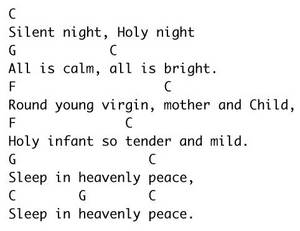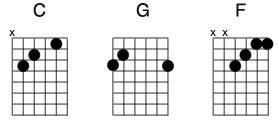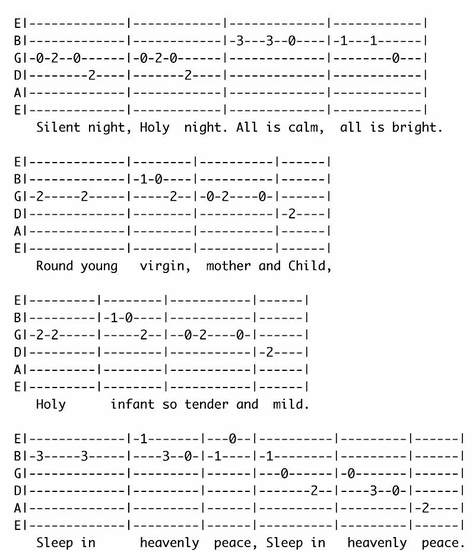Read Guitar Music
Ready to read guitar music?
Reading music is an essential skill to develop if you plan to start playing guitar. Guitarists, and those who write songs for guitar, have a few ways to pass those songs along...
- Record it and hope that the listener can figure out how to play it...
- Meet you in person, play a song, and teach it to you...
- or... Write the song down in a format that you can understand.
It's easier to read guitar music than it was to learn how to read this page. Just learn the basics, then build on those.
Microsoft once estimated that 90% of those who use Word, never use 75% of its features. The same is probably true with music notation. If you learn about 25% of it, you should be able to read 90% of all guitar music.
You have a choice of three notations to learn.
- Chord Charts, or Fake Sheets
- Tablature, aka Tab
- Music Notation, and...
- Once you can read guitar music with competence, there is a fourth notation used by many musicians as a short-hand: Nashville Notation.
The Basics
If music notation is like software... you can concentrate on learning about 25% of it, then build as you need to.
But which 25%? And which notation system has the right 25%?
Most beginners want to play familiar songs. They learn chords first... and are not capable of difficult solos. So to read guitar music, start with the notation that fits... Chord charts!
If you already know a few chords, and are ready for a simple solo... one of those famous riffs we hear on the radio every day. Then it's time to learn to read guitar music in TAB form.
As you make progress, or if you are interested in classical, flamenco, or other finger-picking styles of playing... then music notation is for you.
Finally, as time goes by and you learn to play with others, it's time to move on to the Nashville Notation System... a flexible shorthand for playing most popular music.
Chord Charts, or Fake Sheets
Chord Charts, sometimes called Fake Sheets, make it easy to read guitar music.
A well-written Chord Chart shows the lyrics to a song with chord names immediately above the words where each chord is to be played, and chord forms.
Sometimes one or more chord must be played as part of an Intro, or when there are no words. For those, the chords are placed above all lyric lines, or between them, in a position relative to where they should be played.
Chord forms, especially for unusual or optional chords, are very helpful. Say you want to learn a song with five chords... but you only know three of them. If the author includes all five chord forms you can both play the song and learn two new chord forms at the same time!
Chord Charts assume that you know the song. There is no information, for example, on rhythm patterns or the melody.
Here's a short sample:
Silent Night by Joseph Mohr & Franz Gruber


Tablature, or TAB
If you are more interested in solo's, or you have not memorized chord forms yet, you might want to read guitar music in TAB form.
Once again, TAB assumes you know the song. There is no standard way to indicate the timing of notes (how long to hold one versus another).
The better TAB notation authors include lyrics, so you get a sense of when to play the notes in relation to the words. Even these, however, have no way to show you how to play a passage with no words (such as an introduction, or a solo in the middle of the song).
I have seen some authors include notes on how to play a passage, but so far such notes are not standardized.
To read TAB, keep in mind that string-1, the high-E, is shown at the TOP. Numbers shown on each line indicate the fret position of the note on that string. So, a 3 on the top line means to play the 3rd fret of high-E string (which happens to be a 'G' note).
Vertical bars mark the end of a traditional measure, or the end of a phrase. If lyrics are given, the notes are plucked in rhythm with the lyrics.
Here is a short sample:
TAB for Silent Night by Joseph Mohr & Franz Gruber

Take a look at the Guitar TAB Guide to learn more about TAB, discover a few sites that list guitar TAB, understand why many sites have shut down, discover software that can help you write TAB, and a get a TAB reference guide!
Music Notation
Music notation is the set of lines, numbers, letters and symbols that most of us were exposed to late in elementary school (sometimes called grade-school or primary-school) or middle school (sometimes junior high school). If you learn music notation, not only will you be ready to read guitar music, but music for any instrument you decide to learn in the future!
The explanation of music notation would take more space than this page allows. If you need or want to learn more, there are some very good books on music theory and music notation, including "A Modern Method For Guitar: 1-2-3 Complete" by William Leavitt, and "Practical Theory Complete, A Self-Instruction Music Theory Course" by Sandy Feldstein
.

Nashville Notation
Down the road... after you learn the other three ways to read guitar music... after you consider yourself a good musician... you may be in a position to work with other musicians in a studio setting. If so, you may be expected to know the Nashville Notation System.
It is another shorthand method that musicians use to document music for fellow musicians. The key advantage is that you can work in any key with the same sheet of shorthand. Why? Because unlike all other methods, the Nashville Notation describes a song using a number system that represents the chords to play in relation to each other.
So a song that includes the chords I, IV and B (as most songs do) could be played in C (using the chords C, F, G) or D (using the chords D, G, A) or any other key that is required. Why would they do this? Usually to accommodate the vocal range of a singer.
Want to learn more? Check out "The Nashville Number System" by Chas Williams.


